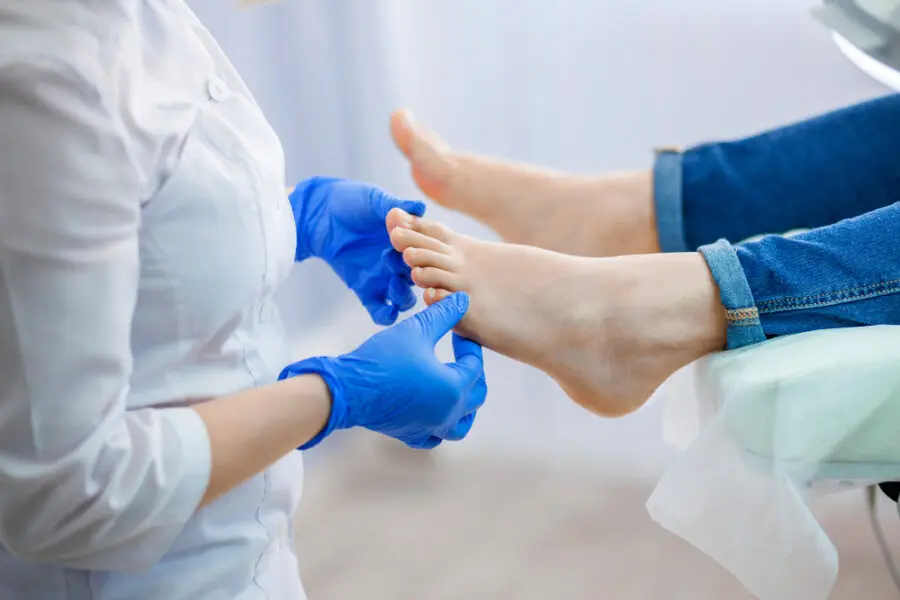
If you think that athlete’s foot (or tinea pedis) only affects athletes, think again! Of course, this pathology does affect many athletes. However, no one is fully immune to this infection, which causes fungus between the toes.
Did you know that more than 10% of the North American population will suffer from athlete’s foot in their lifetime? And adult men are particularly at risk.
Tinea pedis is the most common mycotic infection in podiatry. Fortunately, there are several ways to help prevent it.
Symptoms of athlete’s foot
Stay alert for signals. The sooner you take action, the more effective your treatment will be.
Apart from the fungus between the toes, the main symptoms of tinea pedis include:
- Redness
- Lesions
- Itching
- Cracks
- Blisters under the foot
- Burning sensation
- Exfoliation of the skin
- Thickening of the skin
- Unpleasant odours
- Whitening of the skin between the toes
In the long term, this pathology can lead to certain complications, including:
- Onychomycosis (nail fungus): this is a fungal infection of the toenails.
- Infectious cellulitis: if your tinea pedis has lingered for too long, it can cause inflammation under the skin and the skin can become infected with bacteria.
If you have any of these symptoms, it is important to see a podiatrist to prevent the infection from getting worse. And if you are diabetic, it is even more urgent to see a podiatrist.
Causes of athlete’s foot
The main causes of athlete’s foot are without a doubt the humidity and perspiration of your feet, which promote the spread of fungus. That’ s why this foot disease often occurs in hot weather.
However, there are other causes:
● Heredity
● Blisters on the feet
● Dermatological diseases
● Wearing shoes that are too narrow and without socks
● Weakened immune system
Preventing athlete’s foot
The most effective way to prevent the spread of this condition is to avoid walking barefoot in wet areas, such as in a gym or public swimming pool.
Since this fungal infection is contagious, certain precautions should be taken. Some of these precautions include the following:
● Do not share bath towels, socks or shoes with others.
● Wear absorbent socks (avoid nylon and polyester, and choose cotton).
● Change socks frequently.
● Opt for comfortable and breathable shoes.
● Clean the inside of your shoes frequently.
● Wash your feet every day.
● Dry your feet after perspiring.
If your feet tend to sweat a lot, you can opt for products such as antiperspirant powders or creams, available at all pharmacies. Foot baths are also recommended.
The podiatrist’s role in treating your athlete’s foot
When home remedies do not work, it is necessary to consult a podiatrist. This foot care professional will be able to make a precise diagnosis of your condition. Sometimes what you think is athlete’s foot may actually be eczema, a bacterial infection or psoriasis, which all have similar symptoms.
After conducting a full analysis of your condition, the podiatrist will be able to design the appropriate treatment. They will prescribe an antifungal medication that is adapted to your specific situation. The antifungal can be administered in the form of a cream, gel, ointment or foam. Follow-up visits are scheduled, depending on the case, to ensure that the treatment is progressing well.
The podiatrist can also give you advice on how to take good care of your feet and reduce the unpleasant effects of tinea pedis. They can also help you choose the best type of socks and shoes to prevent sweating.
PiedRéseau: a network of podiatrists to treat your athlete’s foot
PiedRéseau regroups some forty podiatric clinics across the province of Quebec. And all of them can effectively treat your foot infections. PiedRéseau clinics also have the latest technology to provide you with the best possible treatment for all your needs.
Schedule an appointment at a PiedRéseau clinic near you and say goodbye to your athlete’s foot!